Southern boom town that is just 24 miles away from dangerous canyon contaminated by plutonium
Scientists have discovered that residents of Santa Fe, New Mexico — less than a half-hour drive from the birthplace of the atomic bomb — are drinking water from a well containing alarming traces of plutonium.
The shocking samples were taken from the ground at Los Alamos, just 24 miles (38 kilometers) from Santa Fe, home to about 90,000 people.
Experts have since warned that the discovery could mean a cleanup project is needed to save the city’s drinking water.
The contaminated land is located near Los Alamos, in the aptly named Acid Canyon, where radioactive waste seeped into the land between 1943 and 1964.
“We must permanently protect the precious, irreplaceable groundwater and the Rio Grande while providing decades of well-paying cleanup jobs,” Nuclear Watch Executive Director Jay Coghlan said in an email to Santa Fe New Mexican last spring.
Residents of Santa Fe, New Mexico (pictured) are drinking from a water source containing alarming traces of plutonium, scientists have discovered
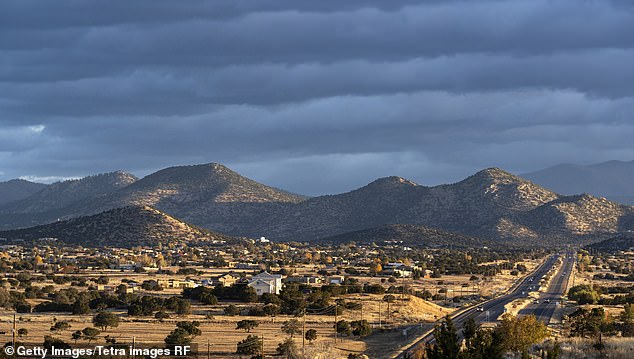
Los Alamos, a city considered the birthplace of the atomic bomb, is still contaminated with high levels of plutonium, experts warn
Coghlan pointed to maps showing contaminated sites in a particular area and claimed there was evidence that a “real clean-up” was needed.
While the water in Santa Fe is still drinkable due to the current levels of plutonium, Coghlan said the radioactive drinking water “should be of great concern to the residents of northern New Mexico.”
In Santa Fe County, up to 3 picocuries per liter of plutonium was measured in the water supply, twice the New Mexico Administrative Code guideline, the paper reported.
Nuclear Watch also collected data on plutonium contamination underground from 1992 to 2023 by marking points on a map.
Huge fires were found in the dumps of an old laboratory used for experiments.
This, of course, happened at Los Alamos National Laboratory, which is just over a mile outside of town. It is one of sixteen research and development sites owned and operated by the U.S. Department of Energy.
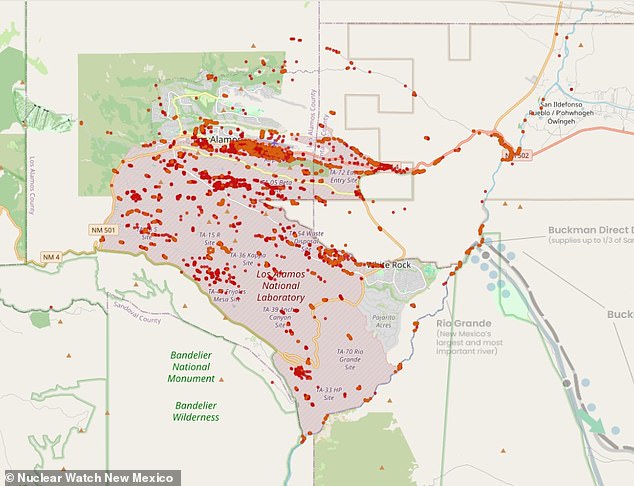
Samples of the soil at Los Alamos have shown the contaminants, which were also found in the Rio Grande, as far away as Lake Cochiti, 30 miles away.
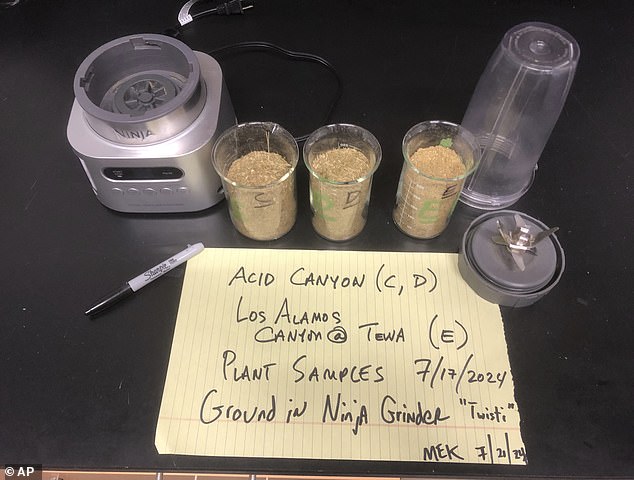
This July 21, 2024, photo shows the vegetation of Acid Canyon and lower Los Alamos Canyon near Los Alamos, NM, after being milled as part of a radiation testing and sampling project
Contamination of surface waters, such as streams and rivers, can be traced back, among other places, to the Acid Canyon hiking trail, where the laboratory dumped waste between 1943 and 1964.
Past pollution could now be migrating downwards to the area’s invisible underground water layer – probably carrying the pollutants across the land of the San Ildefonso Pueblo and the Rio Grande in, warned Coghlan.
The river feeds the Buckman Direct Diversion Project, a system of integrated infrastructure that diverts as much as 2.8 billion gallons of surface water to Santa Fe each year.
That water accounts for nearly half of Santa Fe’s public drinking water supply, and Coghlan says that’s cause for concern.
Over the past 40 years, Santa Fe’s population has nearly doubled to about 90,000. In a 2019 national survey, the city was named a “boom town.”
In the years since, the city has seen an increase of about 5,000 residents, an increase of about 6 percent. The number of occupied houses and the income per capita have also increased.
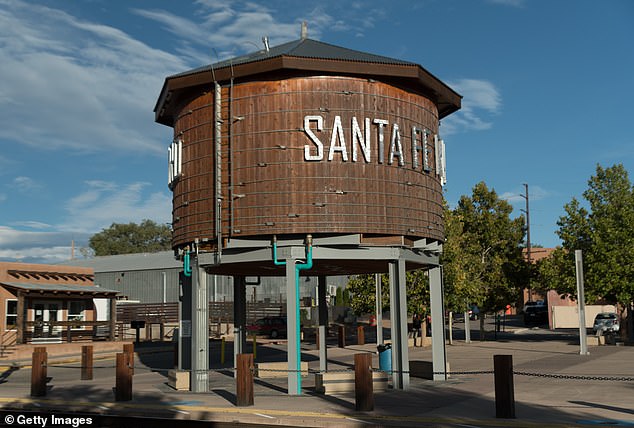
The lake itself is 30 miles west of Santa Fe, which has a population of about 90,000. A cleanup may be needed to save the city’s drinking water
News of the Acid Canyon contamination comes nearly 20 years after the Department of Energy and the University of California (the lab’s previous owner) entered into an agreement with the New Mexico Environment Department to clean up the contamination.
Nuclear Watch data shows that decades-long efforts have so far been unsuccessful in cleaning up the fallout. NMED wants to completely clean up one of the dumps, at a cost of more than $800 million, to protect Santa Fe’s drinking water.
Currently, radiation levels are not high enough to be harmful to hikers on the Acid Canyon Trail, but Coghlan pointed out another danger that could arise if a fire breaks out.
“If Acid Canyon were to burn in a wildfire, and we know that threat is real, that could pose a hazard in the form of respirable plutonium released into the air by the wildfire,” he said.
Coghlan warned that inhaling smoke can lead to lung cancer. Dr. Michael Ketterer, professor emeritus of chemistry and biochemistry at Northern Arizona University, also expressed Coghlan’s concerns.
“I’m just trying to show the people of New Mexico what the truth is,” he said after collecting and analyzing plutonium samples at trailheads in Acid Canyon. “I see a lot of things here that we should be concerned about.”
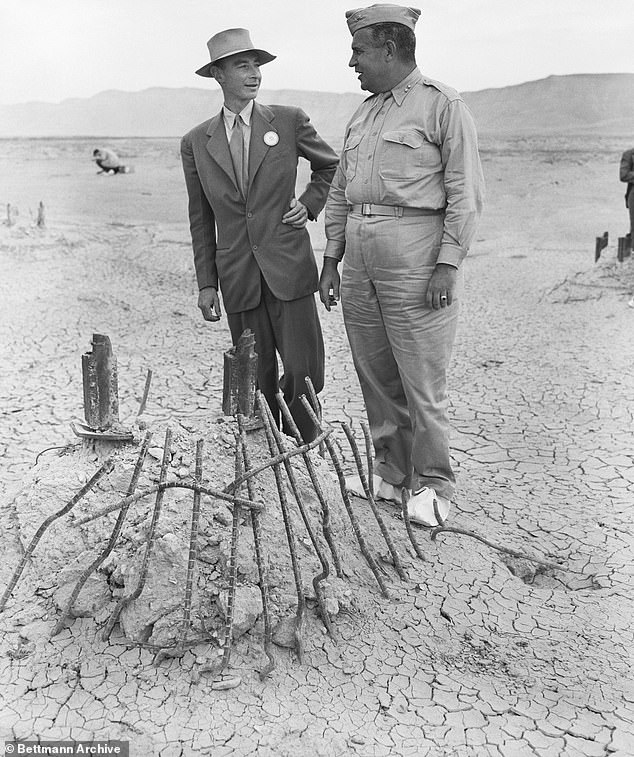
Major General Leslie Groves (right), head of the Manhattan Engineering District where the first atomic bomb was developed, and Dr. J.R. Oppenheimer, director of a top-secret project, discuss the secret program that led to the plutonium contamination that remains at the site today.
“We can’t really predict where it’s going to go and how bad it’s going to get,” he continued, about the possibility of a fire that could create deadly conditions in the area.
Surrounding communities could also be at risk, including historic Santa Fe, The shocking pollution data left Ketterer wondering whether official warnings should be posted along the trail.
“I’ve never seen anything like this in the United States,” Ketterer. “This is a no-holds-barred area.”
He then compared radiation levels in the popular park to those at the site of the Chernobyl nuclear disaster in the Soviet Union.
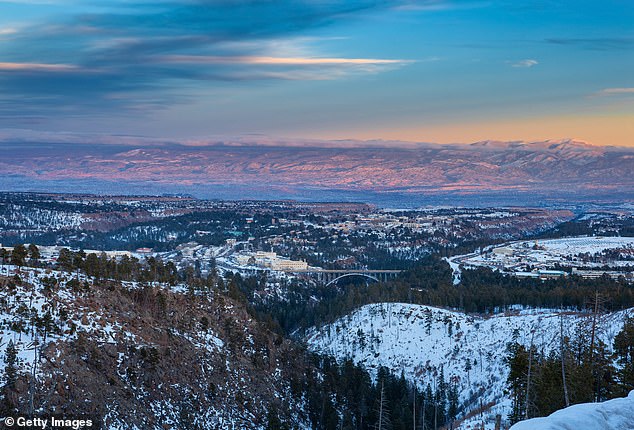
Above is a rural winter photo overlooking Los Alamos, New Mexico at left and center, the Omega Bridge at center, and the Los Alamos National Laboratories at right
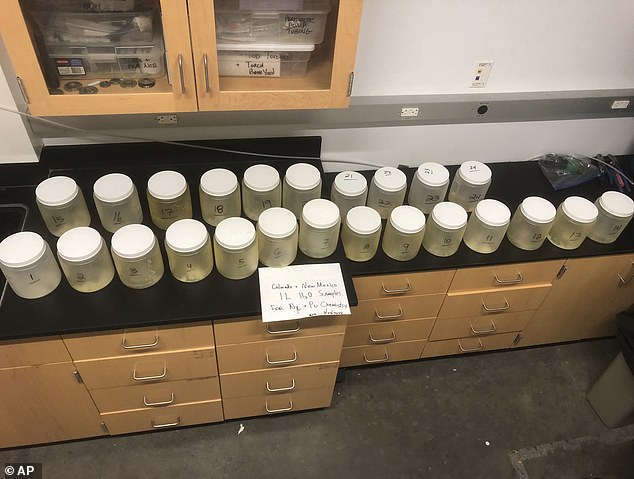
This July 22, 2024, image provided by biochemist Michael Ketterer shows jars containing water samples from Acid Canyon in Los Alamos, New Mexico
“It’s just an extreme example of very high concentrations of plutonium in soils and sediments,” the biochemist said. “It’s hidden from view.”
The biochemist also noted that the high concentrations of plutonium in the gorge’s water posed a greater environmental risk to communities and habitats downstream.
‘Under monsoon storm current conditions, Pu [plutonium] laden water and sediment flow through Acid Canyon and into Los Alamos Canyon and ultimately the Rio Grande,” he said noted in a presentation for New Mexico Nuclear Alert.
Radioactive plutonium in groundwater can also be taken up by plants, entering the food chain via local herbivores that eat vegetables, Ketterer said. It can also spread as ash into the air after increasingly frequent wildfires.
“This is one of the most shocking things I have ever encountered in my life,” the biochemist recently said The guard of the disturbing discovery.
Meanwhile, the cleanup of the lab’s Cold War sites is only half complete, the DOE reports.
If the department’s plans are finalized, all of the pits and shafts will be dug and the radioactive waste will be stored at Carlsbad’s Waste Isolation Pilot Plant.
